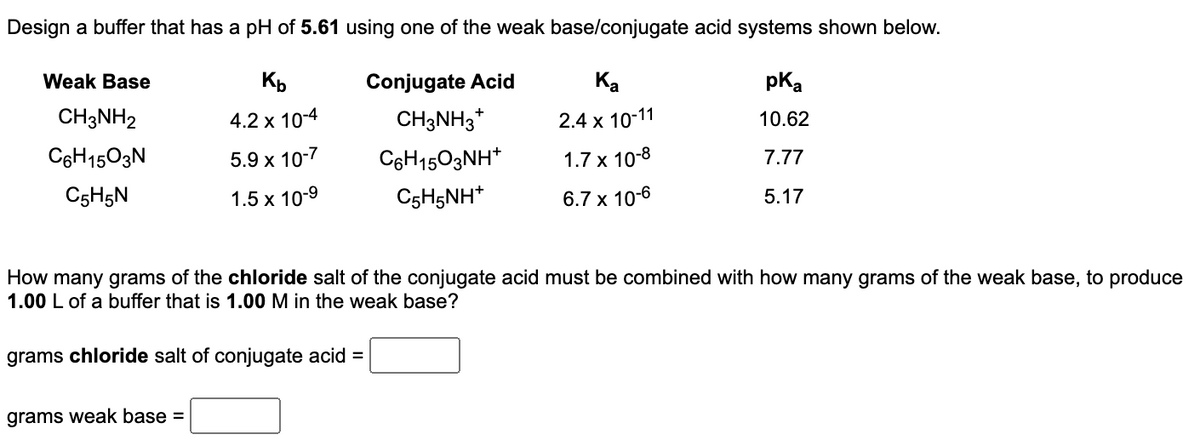Design a buffer that has a pH of 5.61 using one of the weak base/conjugate acid systems shown below. Weak Base Kb Conjugate Acid Ka pka CH3NH2 4.2 x 10-4 CH3NH3* 10.62 2.4 x 10-11 1.7 x 10-8 C6H1503N 5.9 x 10-7 C6H1503NH+ 7.77 C5H5N 1.5 x 10-⁹ C5H5NH+ 6.7 x 10-6 5.17 How many grams of the chloride salt of the conjugate acid must be combined with how many grams of the weak base, to produce 1.00 L of a buffer that is 1.00 M in the weak base? grams chloride salt of conjugate acid = grams weak base =
Design a buffer that has a pH of 5.61 using one of the weak base/conjugate acid systems shown below. Weak Base Kb Conjugate Acid Ka pka CH3NH2 4.2 x 10-4 CH3NH3* 10.62 2.4 x 10-11 1.7 x 10-8 C6H1503N 5.9 x 10-7 C6H1503NH+ 7.77 C5H5N 1.5 x 10-⁹ C5H5NH+ 6.7 x 10-6 5.17 How many grams of the chloride salt of the conjugate acid must be combined with how many grams of the weak base, to produce 1.00 L of a buffer that is 1.00 M in the weak base? grams chloride salt of conjugate acid = grams weak base =
Chemistry: An Atoms First Approach
2nd Edition
ISBN:9781305079243
Author:Steven S. Zumdahl, Susan A. Zumdahl
Publisher:Steven S. Zumdahl, Susan A. Zumdahl
Chapter14: Acid- Base Equilibria
Section: Chapter Questions
Problem 4RQ: A good buffer generally contains relatively equal concentrations of weak acid and conjugate base. If...
Related questions
Question

Transcribed Image Text:Design a buffer that has a pH of 5.61 using one of the weak base/conjugate acid systems shown below.
Weak Base
Ka
Kb
4.2 x 10-4
pka
Conjugate Acid
CH3NH3*
CH3NH2
2.4 x 10-11
10.62
C6H1503N
5.9 x 10-7
C6H1503NH+
1.7 x 10-8
7.77
C5H5N
1.5 x 10-⁹
C5H5NH*
6.7 x 10-6
5.17
How many grams of the chloride salt of the conjugate acid must be combined with how many grams of the weak base, to produce
1.00 L of a buffer that is 1.00 M in the weak base?
grams chloride salt of conjugate acid =
grams weak base =
Expert Solution
This question has been solved!
Explore an expertly crafted, step-by-step solution for a thorough understanding of key concepts.
This is a popular solution!
Trending now
This is a popular solution!
Step by step
Solved in 5 steps with 3 images

Knowledge Booster
Learn more about
Need a deep-dive on the concept behind this application? Look no further. Learn more about this topic, chemistry and related others by exploring similar questions and additional content below.Recommended textbooks for you

Chemistry: An Atoms First Approach
Chemistry
ISBN:
9781305079243
Author:
Steven S. Zumdahl, Susan A. Zumdahl
Publisher:
Cengage Learning

Chemistry
Chemistry
ISBN:
9781305957404
Author:
Steven S. Zumdahl, Susan A. Zumdahl, Donald J. DeCoste
Publisher:
Cengage Learning


Chemistry: An Atoms First Approach
Chemistry
ISBN:
9781305079243
Author:
Steven S. Zumdahl, Susan A. Zumdahl
Publisher:
Cengage Learning

Chemistry
Chemistry
ISBN:
9781305957404
Author:
Steven S. Zumdahl, Susan A. Zumdahl, Donald J. DeCoste
Publisher:
Cengage Learning


Chemistry & Chemical Reactivity
Chemistry
ISBN:
9781133949640
Author:
John C. Kotz, Paul M. Treichel, John Townsend, David Treichel
Publisher:
Cengage Learning

Chemistry & Chemical Reactivity
Chemistry
ISBN:
9781337399074
Author:
John C. Kotz, Paul M. Treichel, John Townsend, David Treichel
Publisher:
Cengage Learning

Chemistry: Principles and Reactions
Chemistry
ISBN:
9781305079373
Author:
William L. Masterton, Cecile N. Hurley
Publisher:
Cengage Learning